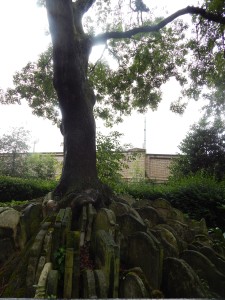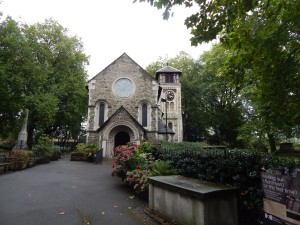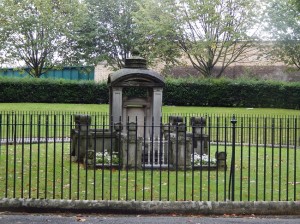 I greatly enjoy browsing on Pinterest. It gives me all kinds of ideas for cooking, for holiday decorations, for hair styles, and also for Tourist Tuesday activities. When I saw a picture of the Hardy Tree on Pinterest, I knew I had to go check it out with my own eyes.
I greatly enjoy browsing on Pinterest. It gives me all kinds of ideas for cooking, for holiday decorations, for hair styles, and also for Tourist Tuesday activities. When I saw a picture of the Hardy Tree on Pinterest, I knew I had to go check it out with my own eyes.
The Hardy Tree is located in the churchyard of Saint Pancras Old Church. Located just a short walk from the King’s Cross St. Pancras Tube Station, you can walk over there after you have your visit to Platfrom 9 3/4. The church is a small and charming little building sandwiched between a large road and a medium sized church yard.
The other noteworthy part of the churchyard is that it is the home of Sir John Soane’s tomb. Now, some of you might be saying, who? I’ll tell you who. Sir John Soane’s was an architect who designed the Bank of England (although today the building has been added to and changed). Also he is the namesake for
the Sir John Soane’s Museum, which if you’re ever in London you should check out. It’s free and it is quirky. (I’m going to go on a bit of a tangent here because you can’t take pictures at the museum so it will  never have its own Tourist Tuesday post) The museum is his former home and is full of antiquities, paintings, and furniture. It’s not your usual house museum. There is one room of paintings. So picture it, paintings on the wall. But then you open the wall like a cupboard and there are paintings on the inside of that. Also there are rooms and hallways of floor to ceiling pieces of ancient Greek and Roman architecture. It’s sort of impressive, and interesting to look at, but also feels a little bit like an OCD hoarder – if that could be a thing.
never have its own Tourist Tuesday post) The museum is his former home and is full of antiquities, paintings, and furniture. It’s not your usual house museum. There is one room of paintings. So picture it, paintings on the wall. But then you open the wall like a cupboard and there are paintings on the inside of that. Also there are rooms and hallways of floor to ceiling pieces of ancient Greek and Roman architecture. It’s sort of impressive, and interesting to look at, but also feels a little bit like an OCD hoarder – if that could be a thing.
Anyway the reason why his tomb is especially important is because it was the inspiration for the iconic red English telephone boxes! In 1924 Sir Giles Scott, who was a trustee of the Soane’s Museum, won the competition with his design which used a dome like the one seen on Sir John Soane’s Tomb. Useless trivia or something that will one day help you win pub trivia? Who knows…
Now back to the tree. It is named for Thomas Hardy, who was in charge of excavating the graveyard. The graves had to be moved because of construction for the Midland Railway’s London terminus. Hardy had the gravestones arranged around the base of an ash tree, which over time grew up and around the stones. Want to read a little more about it? This guy write beautifully about the Hardy Tree.
I found it really fascinating to look at it and it made me think about the passage of time and how things change. Look at how the tree trunk is enveloping some of the headstones. Meanwhile, some further away from the trunk are practically submerged in the ground. I thought it was amazing to see how the tree was tangled up with the gravestones.





